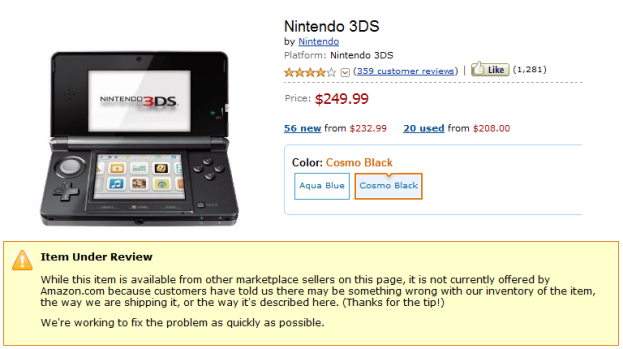 The Nintendo 3DS has been one of the hot items this year, but Amazon has frozen its sales. “While this item is available from other marketplace sellers on this page, it is not currently offered by Amazon.com because customers have told us there may be something wrong with our inventory of the item, the way we are shipping it, or the way it’s describe here. (Thanks for the tip!). We’re working to fix the problem as quickly as possible,” Amazon’s product page for the 3DS reads.
The Nintendo 3DS has been one of the hot items this year, but Amazon has frozen its sales. “While this item is available from other marketplace sellers on this page, it is not currently offered by Amazon.com because customers have told us there may be something wrong with our inventory of the item, the way we are shipping it, or the way it’s describe here. (Thanks for the tip!). We’re working to fix the problem as quickly as possible,” Amazon’s product page for the 3DS reads.
This could possibly have to do with Amazon’s sales supply, but there have been complaints about a manufacturing issue. Some have complained that the top half of the 3DS, the portion with the screen, doesn’t latch properly, causing it to “wobble” as many customers have said. As a result, when the device is closed the two halves can scratch against each other. One NeoGaf forum user contacted Nintendo to ask about the malfunction, and reportedly was told that: “The flip-screen is loose when it’s opened, please inform them that Nintendo has confirmed as long as the upper screen locks into place, the unit is within Nintendo’s design specification. Customers can call 1-800-255-3700.”
If a Nintendo rep actually gave this response, it would appear that the company knows the screen isn’t as secure as customers think it should be and as long as the clamshell device is locking into place when shut, it’s fine. And by fine, Nintendo likely means does not qualify for a refund.
It seems like the 3DS hype hasn’t panned out quite as Nintendo wished. In April, Nintendo announced it missed its projected sales mark for the handheld gaming device and that the company needed to improve its efforts to promote the product. But frozen sales at Amazon, the Internet’s most prolific retailer, aren’t going to help boost sales numbers at all. And even if the issue isn’t hardware-related, the speculation circulating the pulled item isn’t going to do Nintendo any favors.
Editors' Recommendations
- Play these 3DS and Wii U games before Nintendo shutters their online features
- As the 3DS eShop closes, devs reflect on a golden age of Nintendo indies
- You need to get this oddball Zelda game for free before the 3DS eShop closes
- The best Fire Emblem games, ranked from best to worst
- The Nintendo 3DS’ best (and weirdest) cult hit is coming to Apple Arcade

